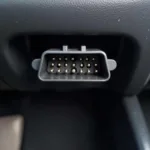An OBD2 scanner, or On-Board Diagnostics scanner, is an essential tool for any car owner. It acts like a window into your car’s computer system, allowing you to understand and diagnose potential issues. But what happens when the very tool designed to help you throws up a “Fail” message?
This comprehensive guide dives deep into the common reasons why your OBD2 scanner might be saying “Fail” and provides clear, actionable steps to help you troubleshoot the issue.
Understanding the Dreaded “Fail” Message
Before we delve into the reasons, it’s important to understand what a “Fail” message on your OBD2 scanner actually means. Contrary to what some might think, it doesn’t always signal a catastrophic failure in your vehicle. Instead, it indicates that the scanner is unable to establish a proper connection with your car’s computer or retrieve diagnostic trouble codes (DTCs).
Common Culprits Behind the “Fail”
Several factors can contribute to this communication breakdown, ranging from simple user errors to more complex technical glitches:
1. Loose or Damaged OBD2 Port or Cable
This is perhaps the most common culprit. Like any connection, a loose or damaged OBD2 port on your car or a faulty OBD2 cable can disrupt the flow of information.
- Solution:
- Visual Inspection: Start by visually inspecting both the OBD2 port on your vehicle (usually located under the driver’s side dashboard) and the OBD2 cable for any visible damage, debris, or bent pins.
- Secure Connection: Ensure the OBD2 connector is firmly plugged into your car’s port. You should hear a click indicating a secure connection.
- Cable Replacement: If you suspect a faulty cable, try using a different OBD2 cable to rule out cable-related issues.
2. Blown OBD2 Fuse
Just like other electrical components in your car, the OBD2 system is protected by a fuse. A blown fuse can effectively cut off power to the OBD2 port, rendering your scanner useless.
- Solution:
- Locate the OBD2 Fuse: Consult your vehicle’s owner’s manual to identify the location of the OBD2 fuse in the fuse box.
- Fuse Inspection: Carefully remove the OBD2 fuse and check for a break in the metal wire inside.
- Fuse Replacement: If the fuse is blown, replace it with a new fuse of the same amperage rating.
3. Incompatible OBD2 Scanner
While the OBD2 standard aims for universal compatibility, some scanners may not be fully compatible with certain car makes or models, especially older vehicles.
- Solution:
- Compatibility Check: Verify that your OBD2 scanner is compatible with your vehicle’s make, model, and year. This information is typically found in the scanner’s user manual or on the manufacturer’s website.
- Scanner Upgrade: If your scanner is outdated or incompatible, consider upgrading to a newer model that supports a wider range of vehicles.
4. Software or Firmware Issues
Just like computers and smartphones, OBD2 scanners rely on software and firmware to function correctly. Outdated or corrupted software can lead to communication errors.
- Solution:
- Software Update: Check for any available software or firmware updates for your specific scanner model on the manufacturer’s website.
- Reset to Factory Settings: If updating doesn’t resolve the issue, try resetting your scanner to its factory settings. Refer to the user manual for instructions on how to do this.
5. Vehicle’s Battery Issues
A weak or failing car battery can disrupt the electrical system, including the OBD2 system.
- Solution:
- Battery Check: Have your car’s battery tested to ensure it’s holding a sufficient charge.
- Battery Charge or Replacement: Charge the battery if needed, or replace it if it’s nearing the end of its lifespan.
6. Faulty ECU (Engine Control Unit)
In rare cases, a faulty Engine Control Unit (ECU), the brain of your car’s engine management system, can prevent communication with the OBD2 scanner.
- Solution:
- Professional Diagnosis: Diagnosing and repairing a faulty ECU requires specialized equipment and expertise. Consult a qualified mechanic or dealership for assistance.
Troubleshooting Tips: A Step-by-Step Guide
- Check the Basics: Begin by ensuring the car’s ignition is turned to the “On” position (engine off).
- Inspect Connections: Visually inspect the OBD2 port and cable for damage, debris, or loose connections.
- Test the Fuse: Locate and inspect the OBD2 fuse in the fuse box, replacing it if blown.
- Verify Compatibility: Double-check that your OBD2 scanner is compatible with your vehicle.
- Update Software: Update your scanner’s software and firmware to the latest versions.
- Inspect the Battery: Ensure your car’s battery is charged and in good condition.
- Seek Professional Help: If the issue persists, consult a qualified mechanic or dealership.
When to Seek Professional Help
While many OBD2 scanner issues can be resolved with basic troubleshooting, some situations warrant professional attention:
- You suspect a faulty ECU or other complex electrical problems.
- You’ve exhausted all troubleshooting steps without success.
- You’re uncomfortable working with electrical components in your vehicle.
OBDFree: Your Trusted OBD2 Resource
Navigating the world of OBD2 scanners and vehicle diagnostics can be daunting. That’s where OBDFree comes in. We are committed to providing you with accurate, up-to-date information and resources to help you understand your car better.
For more in-depth guides and information on OBD2 scanners, check out our articles on NYS OBD2 inspection, using Wireshark with OBD2 to USB cable, and OBD2 MAF reading.
Conclusion
An OBD2 scanner saying “Fail” can be frustrating, but understanding the potential causes and following these troubleshooting steps can help you get to the root of the problem. Remember, a little knowledge goes a long way in empowering you to take control of your car’s health.
If you need further assistance, don’t hesitate to contact our dedicated support team via WhatsApp at +1(641)206-8880 or email us at [email protected]. We’re available 24/7 to assist you.


